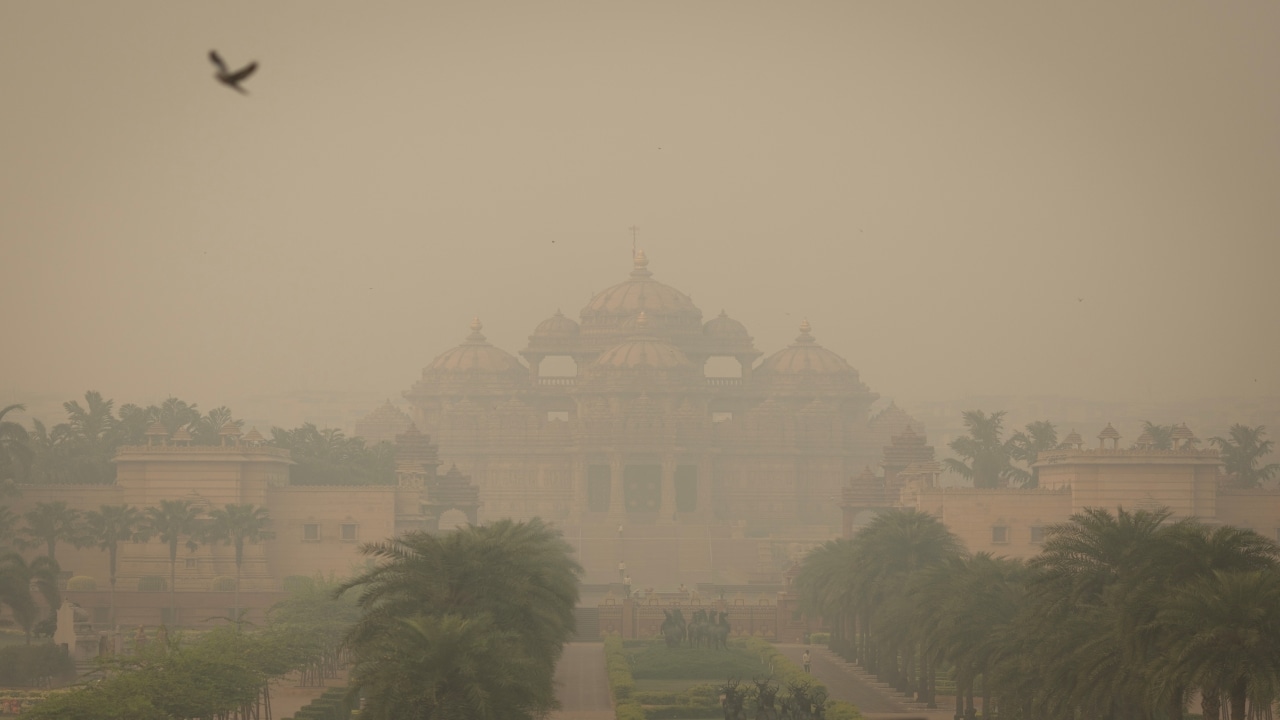Advertisement|Remove ads.
GRAP-III halts construction across Delhi-NCR: Developers urge on need for 'balance'
Developers, industry bodies, contractors and large project owners agree that public health must come first. But they argue for a more nuanced, data-driven and site-specific approach, pointing to the massive social and economic implications of blanket construction bans.

As the air quality in Delhi-NCR plunges into the “severe” category, prompting the enforcement of GRAP Stage III, construction sites across the region have once again fallen silent. While the curbs are aimed at protecting public health, they have triggered fresh concerns across India’s real estate and infrastructure sectors—sectors that collectively employ lakhs and anchor one of the largest economic ecosystems in North India.
Developers, industry bodies, contractors and large project owners agree that public health must come first. But they argue for a more nuanced, data-driven and site-specific approach, pointing to the massive social and economic implications of blanket construction bans.
Livelihoods at the Centre of the Storm
Vijay Harsh Jha, founder and CEO of VS Realtors, captures the immediate human impact of GRAP-III.
“While pollution control measures are absolutely necessary to safeguard public health, we must also recognise that the livelihoods of millions of workers depend on construction activities,” he says. “The construction ban not only halts real estate projects but also leaves thousands of daily-wage labourers without income or security.”
According to him, repeated shutdowns—during monsoon and pollution season—disrupt delivery cycles, escalate costs and create anxiety among homebuyers. “We need a more balanced and sustainable approach—one that protects health, livelihoods and project timelines together,” he adds.
Echoing this concern, Parveen Jain, President of NAREDCO, warns that an indiscriminate halt “would have immediate economic consequences,” especially for unskilled workers dependent on daily wages. Construction, he notes, is a key driver of economic momentum and employment.
He advocates allowing RERA-registered, low-dust sites to continue operations under strict monitoring. “Every site already has real-time pollution sensors transmitting data to CPCB. Sites consistently recording levels below GRAP-III thresholds should be allowed to operate,” he says, arguing for a fairness-based, site-specific regulatory model.
Developers Support GRAP, Stress Need for Balance
Despite operational disruptions, most developers emphasise that the intent of GRAP-III is vital.
Pradeep Aggarwal, Founder & Chairman of Signature Global (India) Ltd, says the company “fully supports” the government’s decision. “While temporary restrictions may cause short-term adjustments, such measures are important for ensuring environmental sustainability,” he says. Signature Global has deployed advanced dust-mitigation systems, covering of raw materials and on-site greenery across its sites.
Ashok Kapur, Chairman of Krishna Group and Krisumi Corporation, says they abide by GRAP norms “in letter and spirit.” But he points out that studies show construction is not the top pollutant. “A blanket ban disrupts timelines, affects homebuyers and impacts the most vulnerable—the labour workforce. There is an urgent need for a more balanced, sustainable solution to this recurring challenge.”
Sahil Agarwal, CEO of Nimbus Realty, also calls Stage 3 a “necessary intervention” but underlines the “immediate impact on timelines and productivity”. He says the industry must now respond with smarter sequencing, modular construction and early-stage planning to minimise disruptions. “Quality and compliance must go hand in hand,” he adds.
Sustainability Taking Centre Stage as Industry Evolves
A notable shift runs through all industry voices: GRAP-III, despite its disruptions, has accelerated the sector’s transition to cleaner construction.
“GRAP reinforces what the market was already gravitating towards—cleaner sites, greener materials, sustainable technologies and healthier environments,” says Vaibhav Kumar Shivhare, Senior VP (Projects & Contracts) at Experion Developers.
He lists fly-ash brickwork, crushed sand, wastewater recycling, efficient HVAC systems, low-VOC paints, performance glass and IGBC/GRIHA-certified projects as the new norm. Tools like BIM, AI-assisted design, off-site fabrication and lean construction have helped maintain efficiency even under restrictions.
“By 2030, green real estate will steer and define the industry’s leadership,” he predicts.
Manoj Gaur, CMD of Gaurs Group, agrees that GRAP has pushed the industry toward “smarter, cleaner and more accountable construction practices.” Dust-mitigation systems, anti-smog guns, cleaner equipment and site management protocols that were once add-ons are now standard across projects. “These measures allow us to maintain construction quality while upholding environmental responsibility,” he says.
Technology-Driven Adaptation Becomes Industry Strategy
The push for technological adoption is also becoming more pronounced as developers find new ways to keep projects on track while meeting environmental norms.
Robin Mangla, President of M3M India, says GRAP-III is “a crucial reminder of our collective responsibility toward cleaner air and sustainable urban growth.” Developers, he notes, are increasingly turning to dust-control systems, green cover planning and cleaner practices. “Such regulations encourage more responsible development and push the industry towards technology-driven solutions,” he says.
Sanjay Dutt, MD and CEO of Tata Realty & Infrastructure Ltd, views GRAP-III as both a challenge and an opportunity. “These measures are necessary to protect public health. The path forward lies in proactive adaptation.”
He highlights how leading developers are deploying real-time air quality monitoring, advanced dust suppression systems and cleaner construction methodologies. “The regulations are being viewed as catalysts for innovation rather than barriers,” he says.
Call for Flexibility and Practical Support
While backing the intent, developers are unanimous in asking for supportive mechanisms to ensure that environmental compliance does not lead to project distress.
Kushagr Ansal, Director of Ansal Housing, says the temporary halt “impacts timelines, labour deployment and material movement,” but also encourages cleaner construction. He emphasises coordinated steps between authorities and industry for balancing the environment with delivery requirements.
Ashish Bhutani, CEO of Bhutani Group, adds that while environmental responsibility is paramount, “the industry also needs practical flexibility to maintain timelines.” Supportive steps from regulators like RERA—particularly “reasonable extensions”—would help developers stay compliant without jeopardising delivery schedules.
A Turning Point for Construction in NCR
The imposition of GRAP-III has once again underscored Delhi-NCR’s struggle to balance two complex priorities—public health and economic activity.
But this year, the industry’s response also shows a deeper shift: sustainability is no longer just compliance; it is becoming a competitive and operational imperative.
Whether regulators adopt site-specific norms or continue blanket restrictions, the real estate sector appears to be recalibrating itself for a future defined by greener, smarter and more responsible construction.
Read Also: Deepinder Goyal’s Continue claims gravity may be a hidden driver of human ageing
Developers, industry bodies, contractors and large project owners agree that public health must come first. But they argue for a more nuanced, data-driven and site-specific approach, pointing to the massive social and economic implications of blanket construction bans.
Livelihoods at the Centre of the Storm
Vijay Harsh Jha, founder and CEO of VS Realtors, captures the immediate human impact of GRAP-III.
“While pollution control measures are absolutely necessary to safeguard public health, we must also recognise that the livelihoods of millions of workers depend on construction activities,” he says. “The construction ban not only halts real estate projects but also leaves thousands of daily-wage labourers without income or security.”
According to him, repeated shutdowns—during monsoon and pollution season—disrupt delivery cycles, escalate costs and create anxiety among homebuyers. “We need a more balanced and sustainable approach—one that protects health, livelihoods and project timelines together,” he adds.
Echoing this concern, Parveen Jain, President of NAREDCO, warns that an indiscriminate halt “would have immediate economic consequences,” especially for unskilled workers dependent on daily wages. Construction, he notes, is a key driver of economic momentum and employment.
He advocates allowing RERA-registered, low-dust sites to continue operations under strict monitoring. “Every site already has real-time pollution sensors transmitting data to CPCB. Sites consistently recording levels below GRAP-III thresholds should be allowed to operate,” he says, arguing for a fairness-based, site-specific regulatory model.
Developers Support GRAP, Stress Need for Balance
Despite operational disruptions, most developers emphasise that the intent of GRAP-III is vital.
Pradeep Aggarwal, Founder & Chairman of Signature Global (India) Ltd, says the company “fully supports” the government’s decision. “While temporary restrictions may cause short-term adjustments, such measures are important for ensuring environmental sustainability,” he says. Signature Global has deployed advanced dust-mitigation systems, covering of raw materials and on-site greenery across its sites.
Ashok Kapur, Chairman of Krishna Group and Krisumi Corporation, says they abide by GRAP norms “in letter and spirit.” But he points out that studies show construction is not the top pollutant. “A blanket ban disrupts timelines, affects homebuyers and impacts the most vulnerable—the labour workforce. There is an urgent need for a more balanced, sustainable solution to this recurring challenge.”
Sahil Agarwal, CEO of Nimbus Realty, also calls Stage 3 a “necessary intervention” but underlines the “immediate impact on timelines and productivity”. He says the industry must now respond with smarter sequencing, modular construction and early-stage planning to minimise disruptions. “Quality and compliance must go hand in hand,” he adds.
Sustainability Taking Centre Stage as Industry Evolves
A notable shift runs through all industry voices: GRAP-III, despite its disruptions, has accelerated the sector’s transition to cleaner construction.
“GRAP reinforces what the market was already gravitating towards—cleaner sites, greener materials, sustainable technologies and healthier environments,” says Vaibhav Kumar Shivhare, Senior VP (Projects & Contracts) at Experion Developers.
He lists fly-ash brickwork, crushed sand, wastewater recycling, efficient HVAC systems, low-VOC paints, performance glass and IGBC/GRIHA-certified projects as the new norm. Tools like BIM, AI-assisted design, off-site fabrication and lean construction have helped maintain efficiency even under restrictions.
“By 2030, green real estate will steer and define the industry’s leadership,” he predicts.
Manoj Gaur, CMD of Gaurs Group, agrees that GRAP has pushed the industry toward “smarter, cleaner and more accountable construction practices.” Dust-mitigation systems, anti-smog guns, cleaner equipment and site management protocols that were once add-ons are now standard across projects. “These measures allow us to maintain construction quality while upholding environmental responsibility,” he says.
Technology-Driven Adaptation Becomes Industry Strategy
The push for technological adoption is also becoming more pronounced as developers find new ways to keep projects on track while meeting environmental norms.
Robin Mangla, President of M3M India, says GRAP-III is “a crucial reminder of our collective responsibility toward cleaner air and sustainable urban growth.” Developers, he notes, are increasingly turning to dust-control systems, green cover planning and cleaner practices. “Such regulations encourage more responsible development and push the industry towards technology-driven solutions,” he says.
Sanjay Dutt, MD and CEO of Tata Realty & Infrastructure Ltd, views GRAP-III as both a challenge and an opportunity. “These measures are necessary to protect public health. The path forward lies in proactive adaptation.”
He highlights how leading developers are deploying real-time air quality monitoring, advanced dust suppression systems and cleaner construction methodologies. “The regulations are being viewed as catalysts for innovation rather than barriers,” he says.
Call for Flexibility and Practical Support
While backing the intent, developers are unanimous in asking for supportive mechanisms to ensure that environmental compliance does not lead to project distress.
Kushagr Ansal, Director of Ansal Housing, says the temporary halt “impacts timelines, labour deployment and material movement,” but also encourages cleaner construction. He emphasises coordinated steps between authorities and industry for balancing the environment with delivery requirements.
Ashish Bhutani, CEO of Bhutani Group, adds that while environmental responsibility is paramount, “the industry also needs practical flexibility to maintain timelines.” Supportive steps from regulators like RERA—particularly “reasonable extensions”—would help developers stay compliant without jeopardising delivery schedules.
A Turning Point for Construction in NCR
The imposition of GRAP-III has once again underscored Delhi-NCR’s struggle to balance two complex priorities—public health and economic activity.
But this year, the industry’s response also shows a deeper shift: sustainability is no longer just compliance; it is becoming a competitive and operational imperative.
Whether regulators adopt site-specific norms or continue blanket restrictions, the real estate sector appears to be recalibrating itself for a future defined by greener, smarter and more responsible construction.
Read Also: Deepinder Goyal’s Continue claims gravity may be a hidden driver of human ageing
Read about our editorial guidelines and ethics policy










/filters:format(webp)https://images.cnbctv18.com/uploads/2023/11/delhi-smog-air-quality-2.jpg)
/filters:format(webp)https://st-everywhere-cms-prod.s3.us-east-1.amazonaws.com/cnbctv18logo.png)
/filters:format(webp)https://images.cnbctv18.com/uploads/2023/11/deepinder-goyal.jpg)
/filters:format(webp)https://images.cnbctv18.com/uploads/2025/10/20250305041212_stock_market_recovery_1280x720.jpg)
/filters:format(webp)https://images.cnbctv18.com/uploads/2022/12/data-centres.jpg)
/filters:format(webp)https://images.cnbctv18.com/uploads/2019/04/2019-04-11T100455Z_1_LYNXNPEF3A0PK_RTROPTP_4_WALT-DISNEY-STREAMING.jpg)
/filters:format(webp)https://images.cnbctv18.com/uploads/2025/11/20250303094748_sensex_nifty_sensex_market.jpg)